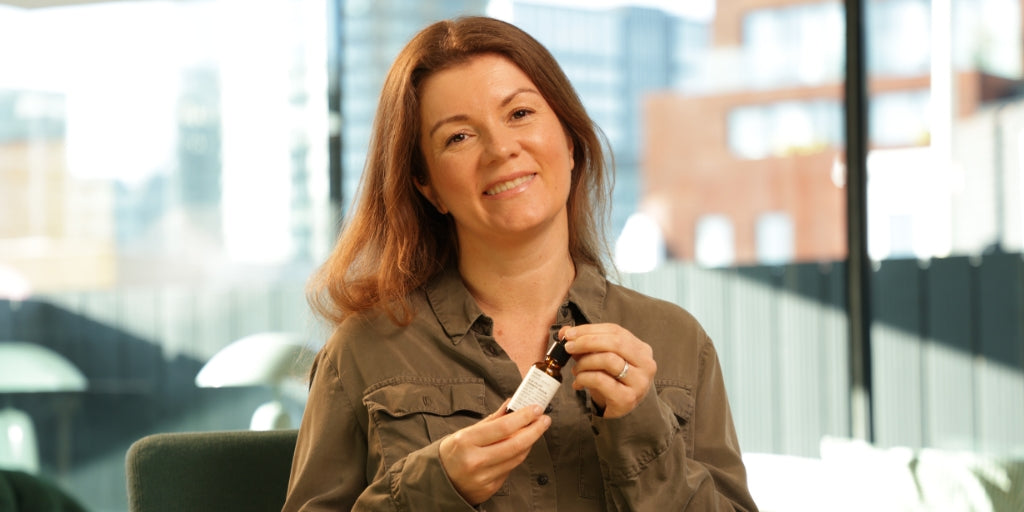It’s that dreaded time of the month. Your period is back and your body is going through its monthly menstrual cycle. Your skin may be feeling the effects with dry and itchy skin on the body as well as oily and more blemish-prone skin on the face.
It is well known that hormones and skin are widely linked. One example you may already know is the effects of stress on the skin. Increases in cortisol hormones when you are stressed can increase oil production leading to more breakouts.
A similar thing happens during your menstrual cycle. Changes in oestrogen, progesterone and testosterone levels in your body can change how your skin feels depending on where you are on the monthly cycle chart. Your facial skin may be more oilier as your body go through the different stages of ovulation and can cause acne before your period.
If you struggle with hormonal acne during your monthly cycle, our ultimate guide is here to help! Read on to learn how you can take care of your skin during menstruation.
WHAT IS THE MENSTRUAL CYCLE?
The menstrual cycle is the process in which a woman’s body prepares itself for pregnancy. A typical menstrual cycle lasts around 28 days but can fluctuate depending on a variety of reasons ranging from existing medical conditions to diet.
The menstrual cycle can be broken down into four main stages.

STAGE 1: MENSTRUATION
This part of the cycle is what you might typically refer to as your period. In this stage, your body sheds the lining of the uterus called the endometrium and you experience vaginal bleeding. The body discards a mixture of blood, uterus lining as well as tissue.
Your body sheds this lining when there is no pregnancy and if there is no fertilised egg.
You may experience period cramps during menstruation and are often most severe during the first few days. They can be similar to muscle cramps that are usually on the tummy but can also be spread throughout your thighs, back and breasts.
Period aches during your period are most likely caused when the muscle wall of the uterus contracts, and these muscles work even harder when the uterus sheds its lining. It is completely normal and most people find relief using a warm compress or taking painkillers to soothe period cramps. However, you should always contact your doctor if you have concerns.
This stage can last between 3-7 days and occurs approximately every 28 days as this is how long it takes for the uterus to break down the lining.
STAGE 2: FOLLICULAR PHASE
The follicular phase of the menstrual cycle starts on the first day of your period up until when ovulation begins.
During this stage, up to 20 ovarian follicles grow to thicken the uterus lining through FSH (follicle stimulating hormones). An egg then grows in each of the follicles and prepares the uterus for pregnancy.
The largest follicle is chosen as the dominant follicle and is the egg that is to be released during ovulation.
Oestrogen levels may also increase during the follicular phase and peak just before ovulation occurs.

STAGE 3: OVULATION
When the egg from the follicular phase matures, it is released during ovulation.
The brain recognises the increased oestrogen levels during the follicular stage and causes the release of the dominant egg. The egg travels through the fallopian tubes towards the uterus.
Ovulation generally occurs two weeks before menstruation.
STAGE 4: LUTEAL PHASE
During the luteal phase, the egg breaks free from its follicular sac allowing the follicle to turn into a corpus luteum. This sits on top of the ovaries.
Both oestrogen and progesterone hormones are released during this phase but progesterone peaks, and is what protects the corpus luteum from breaking down when fertilised.
If the egg is not fertilised, then oestrogen and progesterone levels will decrease causing the corpus luteum to break down. The cycle continues where menstruation occurs.
Many women may experience PMS during the luteal stage. PMS stands for premenstrual symptoms and are often characterised by mood swings, bloating, muscle aches and tenderness.
WHAT CAUSES IRREGULAR PERIODS?
Periods can be irregular for a variety of reasons including puberty, existing medical conditions like endometriosis, PCOS (polycystic ovarian syndrome) as well as medication.
Young girls who have just started menstruating may find that their periods are irregular for the first two years and start to stabilise after.
You should always contact your GP for further information and how to treat irregular period symptoms.

WHICH HORMONES CAUSE HORMONAL ACNE?
When you go through the menstrual cycle, your hormones fluctuate. Varying levels of oestrogen, progesterone and testosterone is what causes your emotions to change and you may even notice changes in your skin.
Acne before periods or during your menstrual cycle is likely due to increases in androgen hormones. For your skin, this means more sebum production that comes into contact with dirt and bacteria that sits on the face. These two combined is what causes our pores to be blocked and hormonal acne to form.
Low levels of oestrogen is also thought to contribute to hormonal acne where oestrogen has ‘anti-sebum’ properties. This allows androgen hormones to increase sebum on oily skin and emerge as hormonal breakouts.
WHY DOES MY PERIOD MAKE MY SKIN SO BAD?
Your skin can often feel a little worse off in different stages of the menstrual cycle.
You may think about hormonal acne as premenstrual flare ups or pimples before your periods as progesterone levels are higher during the Luteal stage of the menstrual cycle. This is because sebum production increases and makes oily skin more prone to spots and cystic acne during menstruation.
When oestrogen is at an all time high, most women find that their skin becomes clearer and is more radiant compared to when oestrogen is low. This may also occur when menstruation starts as this is when progesterone levels decrease.
We may experience hormonal acne around our chin as well as itchy skin before ovulation.
NATURAL AND ORGANIC SKINCARE ROUTINE FOR HORMONAL ACNE:
If you are struggling to combat hormonal acne, here is a simple four step skincare routine that you can follow at home!

STEP 1: CLEANSE WITH A HYDRATING CLEANSER
Cleansing is perhaps the most important step in a skincare routine to fight acne caused by periods. This is because you want to wash away all the bacteria that has built up and stop it from clogging pores on oily, hormonal skin.
The best cleansers for hormonal acne are ones that are gentle and do not irritate existing breakouts.
At Evolve Beauty, our Gentle Cleansing Melt is an organic cleansing balm that uses natural sugars to dissolve makeup and oils from the day. Infused with organic Baobab oil, this natural cleanser will leave your skin feeling nourished and soothe itchy skin.
Using dry hands, take your Gentle Cleansing Melt and gently massage in circular motions all over the face. Be sure to take your time in application and taking care when massaging over the eye area. Add water to emulsify your favourite cleansing balm into a milk and rinse with warm water.

STEP 2: BALANCE SENSITIVE SKIN WITH AN ORGANIC TONER
After cleansing the skin, reintroducing hydration is key to repairing the skin’s moisture barrier.
This step will help to rebalance the skin and calm immediate redness or irritation.
Using a natural exfoliating toner will also help to fight hormonal breakouts, brighten dull skin and help to refine large pores.
Our Liquid Radiance Glycolic Toner uses both natural AHAs (alpha-hydroxy-acids) and BHAs (beta-hydroxy-acids). AHAs exfoliate the skin at the surface level allowing to smooth any texture whilst BHAs penetrate deep into the skin’s pores, lifting dirt and bacteria to prevent further breakouts.
Liquid Radiance Glycolic Toner uses Glycolic Acid from Sugarcane and natural Salicylic Acid from Willow Bark to achieve smoother skin texture for irritated skin during your menstrual cycle.
Simply apply on the palm of your hands or on a reusable cotton pad and sweep gently over the skin.

STEP 3: USE A NATURAL SERUM FOR SENSITIVE SKIN TO TARGET BLEMISHES
The addition of a hydrating serum in your everyday routine will allow you to target specific skincare concerns that might arise during your period. You can use a blemish treatment during this step to reduce inflammation of those pesky spots on your chin.
Our Rainforest Rescue Blemish Serum can be used all over your skin or as a natural spot treatment. Containing an Amazonian blend of Acai and Copaiba, this serum will control excess sebum production whilst helping to reduce the size of pores.
This is perfect for sensitive and oily skin types and for those who are blemish-prone during their hormonal cycle.

STEP 4: USE A NATURAL MOISTURISER TO HYDRATE
To lock in all that moisture you just applied, it’s important to apply a natural moisturiser so your skin reaps the benefits of your perfected skincare routine for hormonal skin.
We recommend our True Balance Lotion formulated with oily and blemish-prone skin in mind. Beautifully infused with Ginger plant cells and Hyaluronic Acid, this lightweight moisturiser will leave your skin feeling hydrated and balanced, whilst giving you a mattified appearance.
True Balance Lotion is also a great daily moisturiser for urban dwellers and frequent jet setters as the Moringa peptides help to reduce congestion and purify the skin.
HOW CAN I STOP HORMONAL ACNE DURING MY MENSTRUAL CYCLE?
While it may be difficult to completely clear hormonal acne and achieve clear skin overnight, there are some ways to prevent acne on your period.
If you have your skincare routine perfected during your menstrual cycle, there are a few other small changes you can make at home.
Here are some simple hygiene and lifestyle hacks that can help you achieve clear skin.

1. CHANGE YOUR PILLOWCASE FREQUENTLY!
We spend 8 hours of our day sleeping so it’s no wonder that dirty sheets that come into contact with our faces can exacerbate hormonal acne.
Changing your pillowcase once a week ensures you’re keeping your bed clean and fresh after your nighttime skincare routine.
Try choosing a dedicated day of the week to switch out your bed sheets to make your life easier.

2. SANITISE YOUR PHONE
Your phone screens are the perfect place for bacteria to breed and spread. You use them everyday to check Instagram or for work calls so it’s safe to say they could do with some cleaning!
Your phone can cause hormonal acne when pressed up against your cheek or on your fingertips leading to the spread of bacteria when you touch your face.
To prevent this, use an alcohol based anti-bacterial cleaner to wipe down your phone regularly!
3. FIND OUT WHAT FOODS TRIGGER HORMONAL ACNE
You may not know it but what you put in your body can have an effect on how your skin looks and feels. Diet and skin are widely linked so it’s important to eat healthy foods to achieve clearer skin.
Poor diet can trigger cystic acne particularly during your period. Foods that are high in sugar, fats and caffeine are just some common triggers.
Try incorporating carrots, avocados and broccoli into your meals for a vitamin-enriched diet as well as nuts and seeds to reduce inflamed acne!
We’ve written some great blogs that you can view below on how diet and skin are linked and what you can do to nourish your body from the inside out.

You may also like:
Diet and the Skin: How to Get Healthier Skin From The Inside





